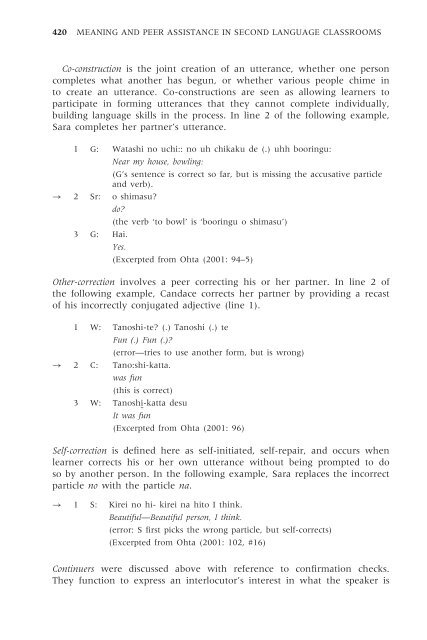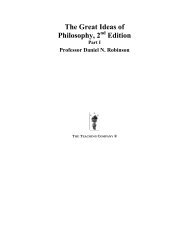Negotiation for Meaning and Peer Assistance in Second Language ...
Negotiation for Meaning and Peer Assistance in Second Language ...
Negotiation for Meaning and Peer Assistance in Second Language ...
Create successful ePaper yourself
Turn your PDF publications into a flip-book with our unique Google optimized e-Paper software.
420 MEANING AND PEER ASSISTANCE IN SECOND LANGUAGE CLASSROOMS<br />
Co-construction is the jo<strong>in</strong>t creation of an utterance, whether one person<br />
completes what another has begun, or whether various people chime <strong>in</strong><br />
to create an utterance. Co-constructions are seen as allow<strong>in</strong>g learners to<br />
participate <strong>in</strong> <strong>for</strong>m<strong>in</strong>g utterances that they cannot complete <strong>in</strong>dividually,<br />
build<strong>in</strong>g language skills <strong>in</strong> the process. In l<strong>in</strong>e 2 of the follow<strong>in</strong>g example,<br />
Sara completes her partner’s utterance.<br />
1 G: Watashi no uchi:: no uh chikaku de (.) uhh boor<strong>in</strong>gu:<br />
Near my house, bowl<strong>in</strong>g:<br />
(G’s sentence is correct so far, but is miss<strong>in</strong>g the accusative particle<br />
<strong>and</strong> verb).<br />
! 2 Sr: o shimasu?<br />
do?<br />
(the verb ‘to bowl’ is ‘boor<strong>in</strong>gu o shimasu’)<br />
3 G: Hai.<br />
Yes.<br />
(Excerpted from Ohta (2001: 94–5)<br />
Other-correction <strong>in</strong>volves a peer correct<strong>in</strong>g his or her partner. In l<strong>in</strong>e 2 of<br />
the follow<strong>in</strong>g example, C<strong>and</strong>ace corrects her partner by provid<strong>in</strong>g a recast<br />
of his <strong>in</strong>correctly conjugated adjective (l<strong>in</strong>e 1).<br />
1 W: Tanoshi-te? (.) Tanoshi (.) te<br />
Fun (.) Fun (.)?<br />
(error—tries to use another <strong>for</strong>m, but is wrong)<br />
! 2 C: Tano:shi-katta.<br />
was fun<br />
(this is correct)<br />
3 W: Tanoshi-katta desu<br />
It was fun<br />
(Excerpted from Ohta (2001: 96)<br />
Self-correction is def<strong>in</strong>ed here as self-<strong>in</strong>itiated, self-repair, <strong>and</strong> occurs when<br />
learner corrects his or her own utterance without be<strong>in</strong>g prompted to do<br />
so by another person. In the follow<strong>in</strong>g example, Sara replaces the <strong>in</strong>correct<br />
particle no with the particle na.<br />
! 1 S: Kirei no hi- kirei na hito I th<strong>in</strong>k.<br />
Beautiful—Beautiful person, I th<strong>in</strong>k.<br />
(error: S first picks the wrong particle, but self-corrects)<br />
(Excerpted from Ohta (2001: 102, #16)<br />
Cont<strong>in</strong>uers were discussed above with reference to confirmation checks.<br />
They function to express an <strong>in</strong>terlocutor’s <strong>in</strong>terest <strong>in</strong> what the speaker is














